A Private Tour today – after the success of recent tours, the request was to see if we could still find some owls, and anything else besides. With the evenings now drawing out, that meant a longer than normal day.
We started out looking for Little Owls in the morning. At the first site, there was too much disturbance today – vans, people – and there was no sign of any owls on the nearer farm buildings. We quickly located one in its new favourite place, right at the back and partly obscured under the lip of the roof, but not really a satisfactory view. With our favourite stubble field, once home to Curlews and Hares, now ploughed in, we didn’t stop here.
Winding our way west inland, a few miles behind the coast, we stopped by some barns to look at the sparrows. The first two we cast our eyes on were sporting chestnut caps and bright white cheeks with a black spot – Tree Sparrows. We had a good look at them from the car, but before we could get out they flew off. Still, great to see a pair still around, given how fast the population has declined in North Norfolk in recent years.
There have been several groups of Fieldfares and Redwings around the area in recent weeks. One of their favoured fields was empty today – perhaps they had already headed off on their way to Scandinavia. But a second group of Fieldfares was still present, hopping around amongst the tussocks of a grazing meadow. A pair of Mistle Thrush were doing the same nearby.
The sunny early morning should have been perfect for sunbathing Little Owls, but perhaps it was already rather too windy to be ideal. Finally, we found a Little Owl around some farm buildings – not in its usual place up on the edge of the roof, and we only saw it when it flew across inside the barn. Adjusting out position, we could just see it perched up on one of the rafters, before it shuffled across and out of sight. A good start, Unfortunately, then the forecast cloud rolled in and the sun disappeared, taking all the Little Owls with it – we tried another site or two, without any further success.
We headed down to the coast. The fields behind Titchwell were full of Brown Hares. They weren’t up to much today – sitting around and doing their best impressions of clods of earth, rather than chasing around and boxing – but one field alone held at least 20. Heading towards Choseley, a bulky passerine flew up onto some overhead wires. A quick look confirmed that it was a Corn Bunting. It sat for a minute or so, and we could see its bill moving – presumably it was singing, doing its best imitation of a jangling set of keys. Unfortunately, we had nowhere to pull off the road and before we had a chance to mount the verge it flew off.
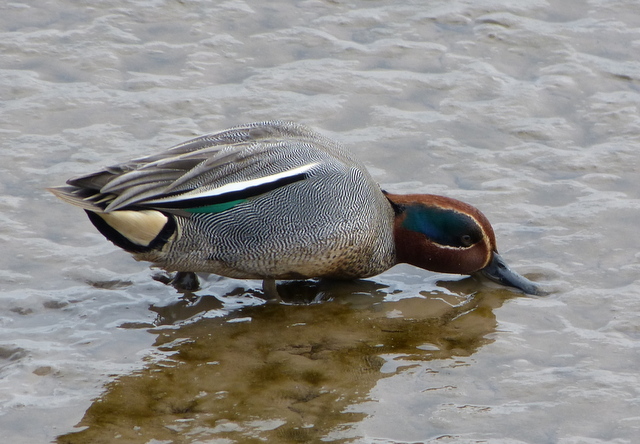 Teal – enjoying the mud at Titchwell
Teal – enjoying the mud at Titchwell
Walking out at Titchwell, the Cetti’s Warblers were singing, loudly! Typically, they were lurking deep in the bushes and would not show themselves. Likewise, a Water Rail squealed unseen from the edge of the reedbed. The drained pool on the grazing marsh towards Thornham has been very productive recently, but was largely empty today, save for a couple of Little Egrets and Redshank. A pair of Marsh Harriers grappled out over the reedbed.
The freshmarsh has been flooded for over two months now for management purposes. The water level was expected to come down before now, but today it was even higher than ever. There was no sign of any of the islands and the poor Avocets which have returned were up to their knees in water where the tallest island had been. Even the ducks seemed less impressed – there were significantly fewer dabbling ducks, a handful of Wigeon and Gadwall, and even the Teal were trying to sit it out on the flattened reeds round the margins. Only the diving ducks seemed happy to see the deeper water – more Pochard and Tufted Duck had returned and a smart drake Goldeneye was out in the middle.
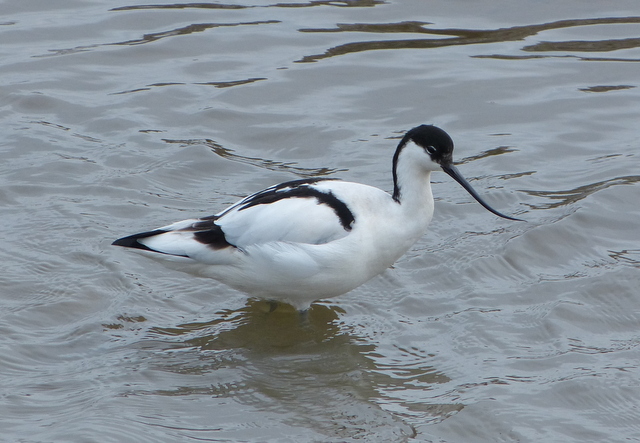 Avocet – waiting for the floodwaters to recede!
Avocet – waiting for the floodwaters to recede!
With the freshmarsh deep under water, the waders have been feeding on the mud on Volunteer Marsh. There were lots of Redshank and Curlew, several Black-tailed Godwit, a couple of Grey Plover, a Ruff and a Turnstone out there today.
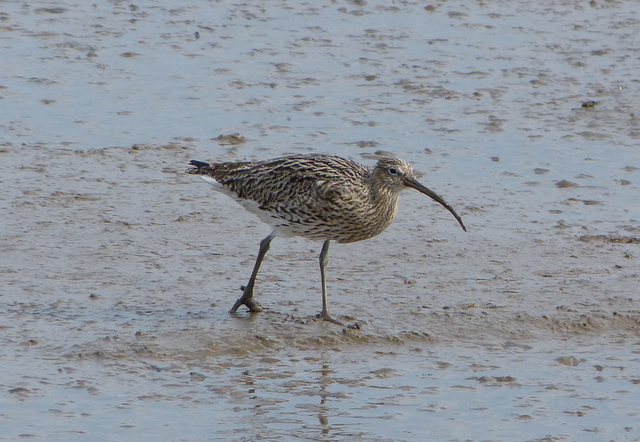 Curlew – on the Volunteer Marsh
Curlew – on the Volunteer Marsh
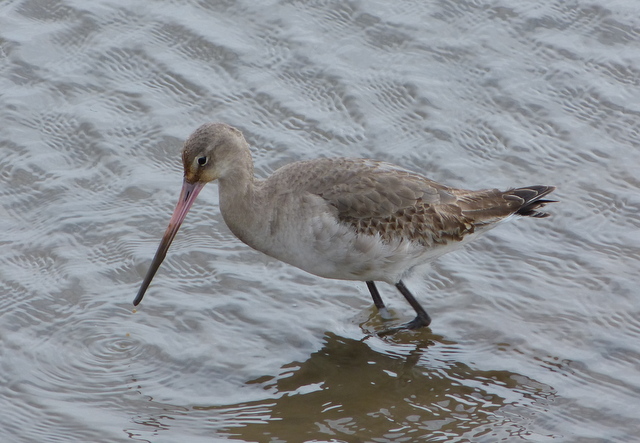 Black-tailed Godwit – searching for some mud
Black-tailed Godwit – searching for some mud
The tidal pools behind the beach held more waders, plus three Pintail – two females and a very smart drake which we admired through the scope. Out on the beach, the tide was heading out and more waders had gathered – lots of Oystercatcher, Bar-tailed Godwits to contrast with the Black-taileds we had just seen, and little groups of Dunlin and Knot. Out on the sea were several Red-breasted Mergansers and a few more Goldeneye.
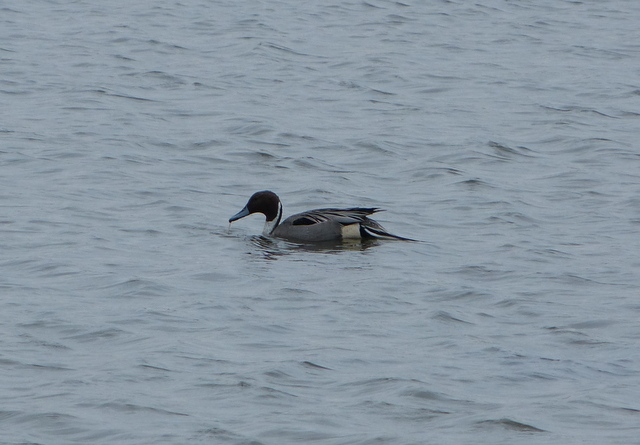 Pintail – this smart drake was on the tidal pools
Pintail – this smart drake was on the tidal pools
As we walked back, all the birds on the tidal pools suddenly took to the air. Looking behind us, we could see why. A Peregrine was heading straight towards us, low over the water. It zipped through at speed, flicking up with barely a movement to get over the bank to the Volunteer Marsh and out of view.
We detoured round via Fen Hide. There appeared to be very little to see here but lurking in amongst the cut reed stems was a small, brown bird with whitish, streaked underparts. A closer look through the scope confirmed it – a Water Pipit. Then it was back to the car for lunch, as the first spots of rain appeared.
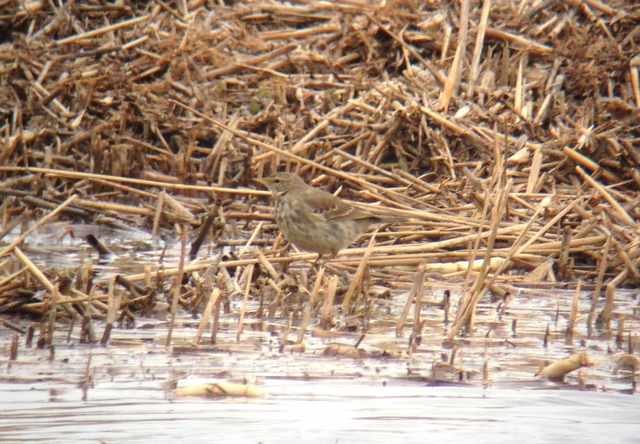 Water Pipit – feeding amongst the cut reed at Fen Hide today
Water Pipit – feeding amongst the cut reed at Fen Hide today
We headed to Burnham Overy next. The wind had picked up considerably and it was already pretty blustery. At least the sun was shining through the clouds again as we walked out across the grazing marshes. A white shape overhead caught the light – rather than the usual Little Egret, this one was larger with a long neck held out in front, a Spoonbill. We watched it fly over towards the heronry and circle round and drop into the trees. The first Spoonbills have just started to return over the last week or so after spending the winter on the south coast. Fingers crossed, they will have another good breeding season.
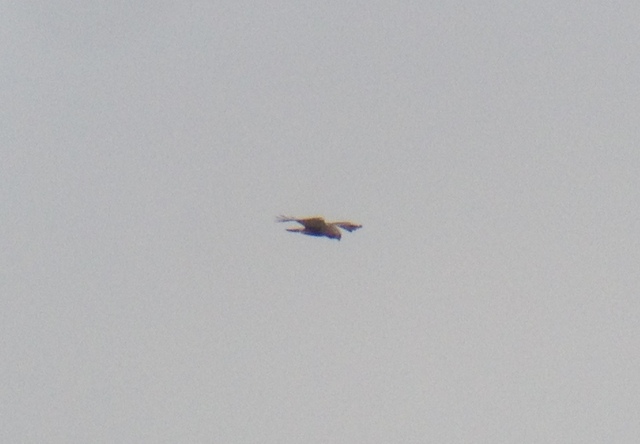 Rough-legged Buzzard – hovering out over the dunes
Rough-legged Buzzard – hovering out over the dunes
Then the cloud rolled in again and it started to spit with drizzle. We could see one of the Rough-legged Buzzards standing in the grass out across the marshes, but it was too windy to get a good look at it through the scope. Thankfully it took off as we walked out and flew towards the dunes, flashing its black belly patch underneath and its black-banded white tail as it turned. There were plenty of other raptors as well – lots of Marsh Harriers, a couple of Common Buzzards and a pair of Kestrels. The female Kestrel was very obliging but the male less so, as he was trying to finish off the remains of a snipe sp! But it was just too windy out on the marshes for any owls.
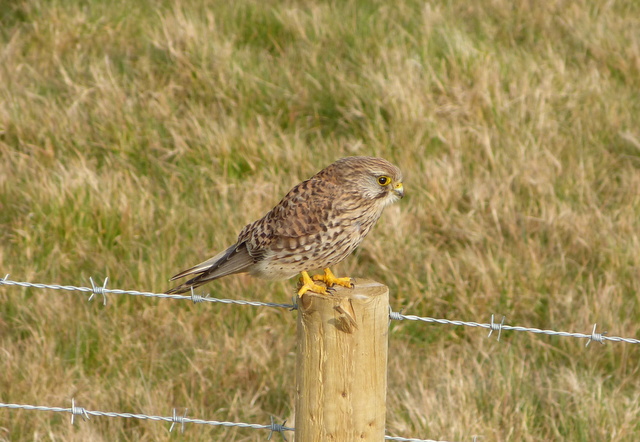 Kestrel – a very accommodating female
Kestrel – a very accommodating female
The large groups of Pink-footed Geese have now moved on, heading north on their way ultimately to Iceland to breed. There were still a few left out on the grazing marshes, though probably now outnumbered by the resident feral Greylags and Canada Geese. In amongst the Pinkfeet were six Barnacle Geese – it is often hard to tell whether these are wild birds or, possibly more likely, part of the growing feral goose population. At least there were still plenty of Brent Geese, though it can’t be long before they head off back to Russia.
 Brent Geese – still here for now, shortly off back to Russia
Brent Geese – still here for now, shortly off back to Russia
We had given up on owls by this stage and had already got back to the car when a glance back at the field across the road revealed a Barn Owl flying across behind us. We watched it fly towards the road and drop down by the verge. We drove along and pulled up in a gateway and found the Barn Owl hiding in the long grass. It saw us coming and flew on along the verge, hunting, turning round at one point and flying back towards us before flipping across the road and out of sight.
 Barn Owl – trying to sneak across the field behind us
Barn Owl – trying to sneak across the field behind us
We stopped in at Holkham briefly on our way. We thought it might be worth a quick look for more Barn Owls, but it was just too blustery and there was no sign of any. We were just walking back to the car when a sharp-eyed member of the group spotted a pale shape in the grass nearby. As it emerged from the grass again, it became clear it was not only a rather smart Stoat, but actually a Stoat in full Ermine. We could see that it was almost entirely white, apart from the black tip to its tail. It seems to have been a good winter for these very smart mammals, but they are still not seen that often. A real treat.
With the day drawing to a close and the light fading, we headed back east and inland again. We had just got out of the car and walked only a short distance before we heard the first Tawny Owl hooting. Then a pair started up further along. Then the first Tawny Owl flew out and landed in a tree in front of us. There was still just enough light to get a really good look at it in the scope. Then it opened its large, rounded wings and glided back through the trees out of view. We stood and listened to more hooting for a few more minutes before calling it a day.
















